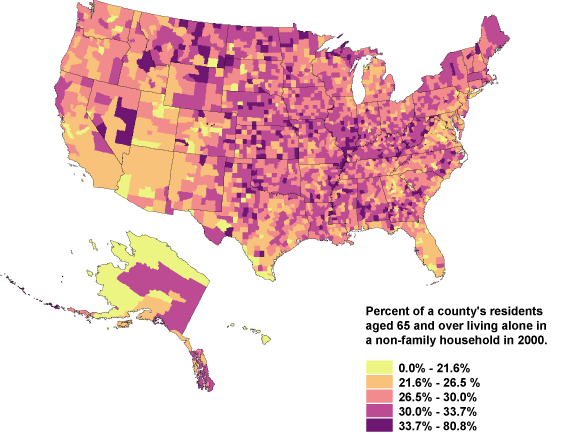http://www.npr.org/series/150002308/family-matters
Family mattered during the Great Depression. Families stuck together. In my wife's family, there was an old aunt who didn't seem to fit into the family tree. When I inquired, I learned that she was an orphan whom the family took in during the Great Depression, even though they had very little to spare themselves. One of the real downsides of the Affluent Society of the second half of the 20th century was that it funded the fragmentation of families. Grand parents could be warehoused. Nuclear families could fragment even further, thanks to lenient divorce laws. Kids catered to the four winds. More and more Americans live alone:
LIVING ALONE
A new chart topic related to this map has been added to the website but the Charts & Trends list has not yet been updated. Click here to view the new chart topic at the national level. As with all CensusScope maps, you can also click on a state in the map below.

Factors contributing to the living arrangements of the aged population are age, sex, and race. A lower proportion of the oldest old population (age 85 and older) are living alone compared to the younger aged persons (age 65 to 74.) Because women live longer than men on average, women are more likely than men to live alone. The ratio of women living alone to men living alone increases with age within the 65 and older population. A higher proportion of aged Whites and Blacks live alone compared to Hispanic persons.
Furthermore, the ability for aged persons to live alone is often coupled with a low incidence of mobility difficulties. Yet, some aged persons are unwilling to give up their independence, wishing to remain alone in their own homes. People living alone often remain in their hometowns in order to be close to family.
The large populations of aged persons in retirement hotspots such as the Southwest and Florida consist of highly mobile aged persons. Percentages of aged persons living alone in these regions tend to be low. A possible explanation for this may be that aged persons who move to these areas tend to relocate with their spouse. Nationally, about 50.1 percent of the population over 65 is married and living with their spouse. The rates are higher in popular retirement areas: Florida, 56.0 percent; Arizona, 58.4 percent; Utah, 61.1 percent. For more information on this topic, please see our chart topic on the marital status of persons 65 and older.
Furthermore, the ability for aged persons to live alone is often coupled with a low incidence of mobility difficulties. Yet, some aged persons are unwilling to give up their independence, wishing to remain alone in their own homes. People living alone often remain in their hometowns in order to be close to family.
The large populations of aged persons in retirement hotspots such as the Southwest and Florida consist of highly mobile aged persons. Percentages of aged persons living alone in these regions tend to be low. A possible explanation for this may be that aged persons who move to these areas tend to relocate with their spouse. Nationally, about 50.1 percent of the population over 65 is married and living with their spouse. The rates are higher in popular retirement areas: Florida, 56.0 percent; Arizona, 58.4 percent; Utah, 61.1 percent. For more information on this topic, please see our chart topic on the marital status of persons 65 and older.
Many may like it. But is it the best thing for American society?
Might our economic troubles be a cloud with a significant silver lining?
No comments:
Post a Comment